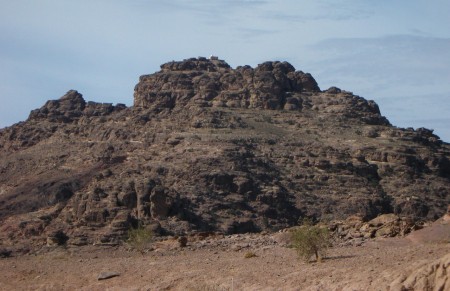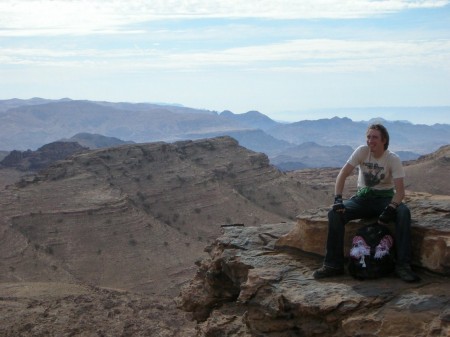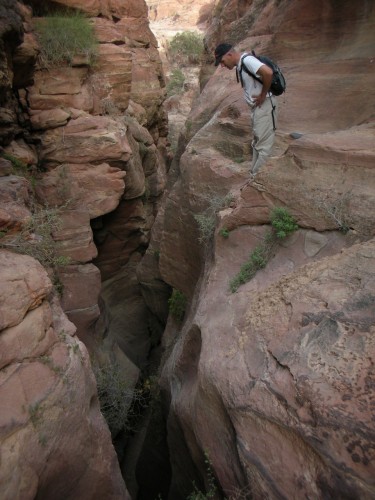This weekend’s hiking trip to Petra really let me know that my body has missed out 4 months of bicycling. I won’t say that I was exhausted after the trip, but my thighs felt like rubber bands by the time we were finished. Located slightly southwest of the main body of Petra, Jebel Haroun (or, in English, Aaron’s Mountain, or Mount Hor) is not a cakewalk to climb to. If I hadn’t had Pat and his son Marshall to help me out in some places, I might never have made it out of there alive!
As I’m starting to learn is customary for trips to the south, we left at 5 in the morning when Pat’s friend and colleague, Andrew, drove down from Irbid to pick us up. The two of them are Boy Scouts scoutmasters, and besides it being a good trip for the four of us, they’re always looking for new parts of Jordan to take their scouts. I was shocked when Pat confessed to me that he and his family had never been to Petra before, even though they’ve lived in the country for 6 years. “We lived in Egypt for years beforehand” he scoffed jovially. “I mean, can Jordan’s piles of rocks really compete against the pyramids and the Valley of the Kings?” Although I should have known better, I still am in the “Wisconsin mindset” and it’s in December mode. I brought 3 layers of clothes and a light jacket as well. I should have paid more attention to Marshall, who was wearing shorts and polo.
The trip down flew by (obviously, I was asleep for almost all of it) and soon we were in Little Petra, the workers’ village that is near the main tourist village of Wadi Musa. Because we were really going into Petra itself, we skipped the main entrance and the walk down the Great Siq, and instead used the employee entrance, sliding and slipping down the slopes of the mountain to reach the little track that the trucks, camels, and donkeys of the Bedouin use every morning and evening. Even though by this point it was 9AM, I was surprised when we reached the intersection with the main path through Petra and saw that there were almost no tourists. At this same hour, same time last month, the place was already packed with shuffling people in khakis. This time though, the place was deserted, and the four us had to constantly fend off Bedouins, wheedling with us to rent donkeys from them to carry us to wherever we wanted. “But what if we want to walk?” I queried, summing up my general feelings towards transportation in Jordan. I mean, we were clearly wearing hiking boots, wearing backpacks weighed down with water bottles, and all of us had akamma, or residency papers, with us. My question was met with baffled stares and eye rolls, as well as some laments about the fact that we were sure to die of exhaustion.
After we crossed over the central path, the road quickly narrowed, then vanished, leaving us with only a compressed, sandy pair of tire skids to mark the trail. An ominous sign in remarkably well-written English loomed over us as we climbed the first hill, leaving Petra behind us: “Venturing from the regular route on your own is not advisable, it is highly recommended that should you wish to do so beyond this point we strongly advise either a local guide or at least one companion.” Great! We were four, so…onward!
The trail, such as it was, wound around the dunes, climbing gradually in some places and sharply in others. We usually kept the Nabatean mountain range to our right, and it was still possible to see some misshapen and badly eroded Nabatean tombs lumped into the red stone, all with the same stair step-shaped crown over all of them that delineated it as a tomb. The sand under our feet was thankfully pressed down enough that it wasn’t too difficult to walk in most places, but it was only a matter of time before I found myself sweating and pulling off all of my exterior layers, leaving me in just my jeans, boots, and t-shirt. Sweating in mid December! Who would have imagined such a novel concept! Well, I’ve learned my lesson after that day.
We followed a worn steel pipe that was haphazardly draped over dunes and rocks. We saw little Bedouin camps, literally no more than holes in the rock walls, with shreds of fabric and and cooking fires in front of them. Herders watched us disinterestedly from the cliffs above us, and the air was silent except for the sound of our feet in the sand, or clicking over occasional gravel.
About thirty minutes into the walk, we were approached by a Bedouin woman who, to judge by Western appearances, looked positively ancient with a wrinkled, leathery face and hands, but the dark straw color of the hair under her hijab betrayed the fact that it was only the hard life of the Bedouin among the rocks that aged her appearance like this. She spoke a little English, and Pat and Andrew conversed with her and her little daughters that crowded around us. She invited us for tea (which we politely declined, gesturing to our full water bottles), and spread a little bag of worn bits of metal in front of us. Marshall and I inspected them closely at her encouragement, and saw that they were actually Roman and Arab coins, all centuries old – tiny monuments to the massive trade empire the Nabateans had established between the entire Arabic peninsula, and civilizations of the northern Mediterranean. The price was right, and both of us bought a few from her. Marshall knew a bit of Latin and was able to translate a bit of the script around some of the coins, but all they seemed to say was “Hail to the Emperor.”
After another hour on the trail, the tire marks vanished entirely and we found the mountain’s grade beginning to increase. Pat pointed ahead, and I saw a tiny, faraway white dot on one of the mountains in the distance, glittering and blinking like a mirage in the morning sun. “There’s the shrine to Aaron,” Pat informed me. “They say that he was buried up here.” Aaron/Haroun is the brother of Moses/Musa, and because he is mentioned in the Qur’an as a prophet, is very important to Islam. The tiny dot we were seeing was the glittering minaret of a mosque, built on the peak of the mountain almost a mile above sea level.

It may look close from here, but it's still 2 hours away. You can see click the picture and see the tiny white dot of the Mosque.
A Wadi (valley) split the stone in front of us, and we skirted its edge for another half hour before we could find a tiny path, no more than a slightly more cleared area of the fist-sized rocks that were now the footpath, and also with small stacks of flat stones set every 50 yards. Someone had put them there, strategically, so we figured that were in the right place and at least probably weren’t going to wander into the desert and die. The ground here seemed to be made to break ankles, so conversation was limited as we kept our eyes to the ground, picking our own paths in an unspoken competition to see which one of us could get to an unspoken point the fastest without looking like we were having a competition. The shimmering dot swam in and out of our vision, crossing behind the peaks of other mountains.
At one point, when we stopped for ten minutes to snack on apples, falafel, and water, we glimpsed the rest of the mosque besides the minaret, and saw the dark shapes of people moving on it. It was the first time we’d seen people in an hour, and seeing other successful climbers reaching the top galvanized us again and we vigorously resumed the hike. By this time, we were entirely on the rock wall of the mountain, utilizing a series of rough switchbacks carved into the side by other feet that had came before. I wondered if Aaron had died while already atop the mountain, or whether his family and friends had carried his remains up the slope. Perhaps they had used this very path! Unlikely that this was their path, of course, but as I slid and tripped over the rocks, I figured that both were equally unlikely. (I read later that he had died elsewhere, but his supposed remains had been reinterred on the mount years later).
After a total of three hours, we finally found ourselves approaching a man-made brick wall, which was a little startling after being surrounded only by nature for the last leg of the trip. As we neared it, we thought it was a solid wall, but it was a trump loi; an optical illusion (yeah; I know many languages) and when we reached an edge, we could see that it actually was a stairway, carved into the stone and impossible to see from straight on. A couple hundred meters beyond that and we were finished: we had arrived at the peak and were standing in front of a small, white, simple Mosque with a single dome on the top. As the day was the holy day, the Mosque closed at noon, otherwise we could have gone inside to see it. Instead, we contented ourselves with climbing on top of the building and eating our lunches while looking out to the west, towards the empty blank whiteness of Palestine and Israel. We couldn’t see any settlements anywhere; just white sand and mountains in that direction. Just north though, we could the Petra’s Monastary Ad-Deir with remarkable clarity. I hadn’t made it out there in the last trip (it’s one of the furthest-out monuments) but unfortunately this wouldn’t be the trip for it either. Even though we had technically only traveled 3.5 miles from our original location (which we could see through a gap in the mountains) as the crow flies, we had actually walked about 7 or 8 miles with all the winding we had to do.
Andrew and Pat, both experienced hikers, judged the sun and knew that we couldn’t stay on the top of that white concrete for too long, basking in the beautiful weather. Pat, Marshall, and myself wanted to try to find a different path down the mountain for fun (the madness that seems always to start with “it’ll be fun”) but Andrew wanted to take the tried-and-true route we had ascended with. We bid him farewell, and for the next two hours, found ourselves picking through the rocks and slippery shale, trying not to slip and plunge down the slope to sheer drops that averaged about 40-50 feet. Pat was a big fan of following “the way of the goat,” as he phrased it, and he was constantly pointing out hoofprints and droppings. “If they can make it through [this route], then we certainly can!” he was fond of saying. Being that goats are smaller and have 4 very agile legs, I didn’t find this particularly reassuring. At least the views continued to be spectacular, and as we entered the completely path-less parts of the mountain, the litter and garbage that seems a natural part of Jordan’s landscape, became less frequently, and finally was gone. I couldn’t argue with that, so I followed the two of them, sliding down rocks forwards and backwards and praying that neither my camera nor myself would be pulverized by a sudden misstep.
At the end of the mountain, we thought we might save some time by cutting through a Wadi and maybe not being completely late to meet up with Andrew (who we had left two hours ago now and we figured had long since arrived back at our meeting place, a dusty little Bedouin shop that said “Buy Bebsi here”), but we turned out to be wrong. The little Wadi had a lot of greenery in it, and when the rainy season eventually comes to Jordan, it’ll be filled with water. Marshall and his father debated how best to traverse the ravine, and Pat firmly told us that “the path of the goat will never fail us. Uh, except for now,” I heard him mutter as I pushed my way through a green, rubbery-leaved bush and saw him standing on the edge of a trench that impeded further movement. It was about 60 feet straight down, and I could a sandy path leading away further to the south in it. On either side of us, there were only high rock walls.
Pat was all for trying to descend into the pit and keep walking, and Marshall and I were a little bit less enthusiastic about this. The heavy backpacks, combined with the smooth, water-worn walls of the chasm were not our allies in this venture, we argued, and Pat finally agreed and we instead looked to the walls for a way to climb upwards and outwards to continue our journey.
This was the most sickeningly horrifying experience I’ve had for the entire trip. Marshall and Pat, both experienced climbers, had no problems but it was a different story for me. I didn’t used to be afraid of heights, but after this 15 minutes of nausea I might be. We edged sideways along the rock wall on a small ledge about 4 inches across, arms hugging the rock. I felt the weight of the water on my back, pulling me downwards, and I scrabbled desperately with my fingers to keep from being dragged off the cliff wall. After moving sideways for a few minutes, we had to go straight up the wall. I looked back the way we had come and saw that there was a place that needed to be swung to; there was no way to go back. The cliff rounded out like a huge belly, which only further caused me to feel like I would fall backward at any moment. I must have stood there, clinging to the wall for 5 minutes while Pat and Marshall encouraged me from a stepping point just above. “Just put your foot on that little bush there, and you can push yourself up,” Pat encouraged. With effort, I stretched my left leg up and gingerly put my weight on the bush, which promptly snapped off. I uttered a low moan and shut my eyes. I heard Pat suck in his breath and start to say something, then stop with a cough. There was silence for a few minutes as we tried to figure out what to do, and I wasn’t much use to anyone at the time; doing all I could to keep my legs from turning to jello and sending me tumbling into the darkness below. Finally, with Marshall holding onto a tree, he and Pat main a human chain, with Pat lowering his leg down for me to catch hold of it. I felt the grit of the sand rub against my face as they dragged me upward. After 10 seconds it was over and I was on the ledge, and the other ascension was not nearly as bad. “Let’s, uh, never do that again, please,” I suggested as we stepped out onto the sunny plateau, leaving the hellish Wadi behind. I asked Pat what he had been about to say to me, when we were still clinging to the cliff. He commented that my shoelace on my boot was untied, and he had notice it about to wrap around an outcropping…but he hadn’t wanted to say anything for fear that I would be startled and lose my grip (in both senses of the word).
That last ascension put us only a dozen yards from the path again, where we had first glimpsed the peak of Jebel Haroun only four hours ago. Finding Andrew farther down the trail talking with the Bedouin family we had spoken with earlier. He leapt up when he spotted us, “What happened to you guys?! I thought you were either dead or had gone out a different way! I’ve been waiting for you for almost 3 hours!” I laughed grimly in response. After a trip like that, bicycling hundreds of kilometers between the Dead Sea and the Red Sea next spring is going to seem easy!
In other news, tonight is the last of the Christmas concerts with Ms. Shareen’s choir. We’re going to Fuheis, which is one of the largest Christian towns in all of Jordan (there are only a total of 3-4). I probably won’t have time to write another entry before then. I’m going to be very busy packing and preparing for the flight back to Chicago, which leaves at midnight, of all times. Thankfully, Nancy is going to give me a ride there. Have a Merry Christmas and a Happy New Year – both the Islamic on the 29th, and the Western, too!




It’s a good thing your poor mother wasn’t there…
Zach: I love Jabal Haroun… best would be, and what I’ve always wanted to do, is to hike this route in the afternoon, then camp at the top to see the sunrise. I am ready to do it if you are!
And, btw, Beidha (Little petra) is a famous off-road biking destination for us, probably starting June? So, maybe we can do cycling+ hiking Haron!
cheers